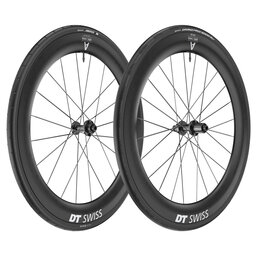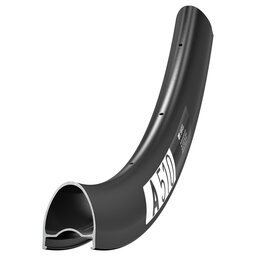
aero+
The symbiosis of drag, handling and efficiency.
TRANSLATIONAL DRAG
Translational drag is the aerodynamic force in the riding direction that slows the cyclist down. It consists of the frontal area of the cyclist (75 %), the road bike and its components (25 %), and speed. To minimize this translational drag, the surface of the overall system needs to be minimized while streamlining the entire road bike and cyclist as far as possible.
If you want to be faster, the key is to reduce the aerodynamic drag of the complete system of road bike and cyclist as the force increases proportionally with the square of speed. From 15 km/h upwards, aerodynamic drag is the greatest resistance a cyclist has to overcome. As the front wheel contributes 8 % of total drag, the wheel’s behavior plays a significant role.

SAILING EFFECT
In crosswind conditions, the cyclist and road bike are exposed to lateral forces that affect riding behavior. When developing wheels for road bikes, the aim is to minimize these lateral forces and maximize the sailing effect – combined with best rideability.
The sailing effect of the wheels can be compared to a sailboat whose sail catches the wind and propels the boat. When cycling, the rim has the same effect and can push the whole system forward. Thus, in moderate crosswind conditions with an inflow of between 0°-20° yaw, the cyclist is no longer slowed down by translational drag but benefits from drag reduction with increasing yaw angle.
Depending on the rim height and shape, this drag reduction can reach negative watt values which even create forward propulsion. Excellent sailing effects with crosswind occur with yaw angles up to 18°. Beyond that, stall occurs that causes drag to increase again.

QUINTESSENCE OF DRAG -
YOUR FRIEND & FOE
Considering the front wheel, which is more susceptible to wind, different effects are observed in different wind conditions. The illustration depicts a model curve which shows the behavior of the front wheel in wind. While the X-axis indicates the angle from which the air flows onto the moving front wheel (yaw), the Y-axis represents drag values (watt).
In headwind and slight crosswind conditions, the cyclist is slowed down by drag. The watt values are positive (above the red line at +/-14° yaw) and drag is perceived as exhausting.
However, lateral crosswind combined with high rim profiles support the cyclist positively. When the watt values reach the negative range (below the red line at 15-20° yaw), the cyclist benefits from the sailing effect of the wheel with propulsion.

ROTATIONAL DRAG
In addition to moving at a certain speed facing translational drag, the rotating parts of the bike such as the wheels are also affected by rotational drag. Rotational drag can be described as the additional friction that occurs between the wheel as it passes through the surrounding air with rotating components.
Rotational drag accounts for up to 25% of total drag compared with 75% for translational drag. Since the spokes are the link to the rim and hub, they take on significant importance that must not be underestimated in the fight against the wind.
Important to know: the lower the rim height, the less the influence of the sailing effect. Therefore, longer spokes in low rim profiles lead to higher rotational drag.
1) Rotational drag 2) Rotation of wheel

STEERING MOMENT
Lateral forces come into contact with the wheel and can influence rideability. Handling therefore needs to be safe and predictable, regardless of external weather conditions such as strong and changing crosswind and headwind. To achieve controlled speed, the AERO+ rim is further refined in this respect with lower steering moment. The cyclist benefits from more predictable, and thus controlled, steering behavior, resulting in longer periods in the aerodynamically optimal position and higher speeds.
WHY IS STEERING MOMENT SO IMPORTANT?
The cyclist feels lateral forces during a bike ride caused by gusty crosswinds and passing vehicles of different sizes and speed. These can have a strong impact on the wheel and are unpredictable and dangerous for the cyclist. The larger the angle of the airflow (yaw angle) and the stronger the wind force, the more the cyclist must constantly adapt to the required counterforce to ride straight in the desired direction.

PHYSICAL EXPLANATION OF STEERING MOMENT
Steering moment is caused by an asymmetric side force distribution acting on the wheel.
WHAT DOES THIS MEAN IN DETAIL?
The side force distribution on a bicycle rim is asymmetric in crosswind conditions. This asymmetry generates a moment (steering moment) around the steering axis, i.e. the axis around which the wheel and fork turn when steering. One goal in the development of the new AERO+ rim shape was to minimize this asymmetry by aiming for an even side force distribution in relation to the steering axis. This was achieved by employing Computational Fluid Dynamics (CFD) and wind tunnel testing.

2 steering axis (represented by the white line)
ROLLING RESISTANCE
Rolling resistance is about more than just the forces which are applied to roll on different surfaces or overcome obstacles. Wider rim inner widths and wider tires support efficiency and riding characteristics such as traction and comfort.
Wider tires tend to have a positive influence on rolling resistance. Thanks to their greater volume, they have a broader contact patch and can be ridden with less air pressure without risking a pinch flat. In comparison with the narrower contact area of narrow tires, the contact area of wider tires is “shorter”. Thus, the tire deforms more easily and rolling resistance decreases.

optimized
aero+ technology
These wheels and rims are AERO+ optimized.














